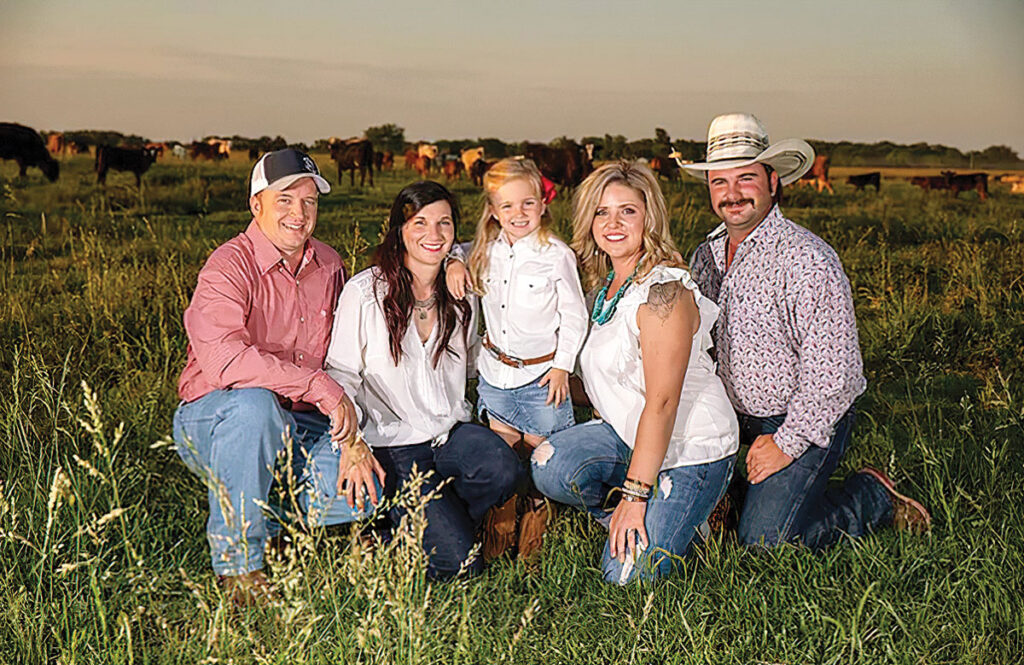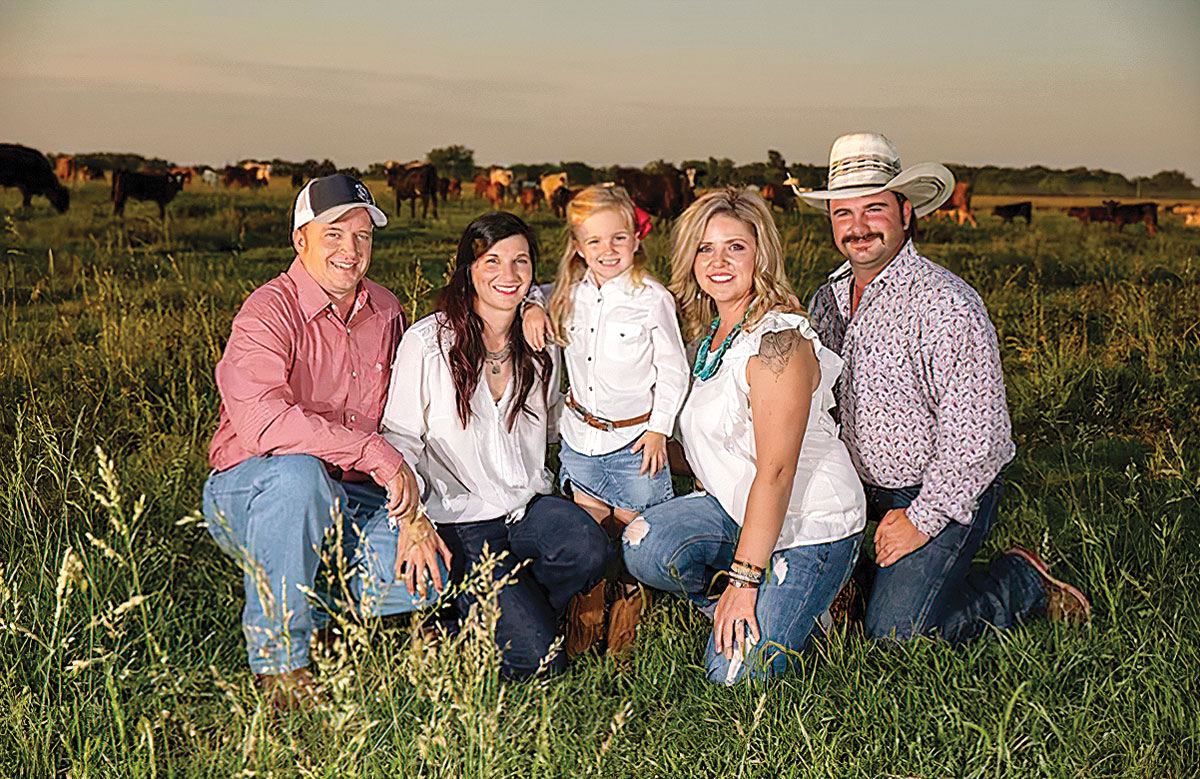
Sisters-in-law Heather Mills and Nichole Dorsey spearhead the family’s beef sales
PRYOR, OKLA. – When Heather Mills was a little girl, she helped warm up and dry off very cold calves her dad brought home. Feeling the warmed calves sucking on her fingers stole the little girl’s heart, and even at that young age she knew her life would always be with cattle.
Heather and her brother Charles Wesley Dorsey’s parents, Charles and Pam Dorsey, bought 155 acres and commercial cattle for a cow/calf operation in Pryor, Okla., in 1976. The senior Charles knew he wanted some day to be his own boss. At the time, he was working for Georgia-Pacific while Pam worked, and still works for, Electrical Services in Pryor. Pam also keeps the ranch’s records and books. The couple progressed by using money from heifers to buy more land and cattle. Charles eventually quit his job to ranch full-time. The Dorsey Ranch now consists of 1,000 commercial cows and 3,000 owned and leased acres. Because they want to continuing expanding, they retain 200 heifers annually using money from steer and culled heifers while Charles Wesley also works fulltime on the ranch.
Females are grouped by age and divided among 14 pastures with another nine sections of 450 acres reserved for silage and dry hay production. The land is double cropped with triticale, alfalfa and soybeans used for silage hay with fescue and Bermuda used for dry hay.
“We also feed soybean flake which is dehydrated soybeans,” Heather explained. “It’s’ ‘cow pudding,’ and they eat it up.”
Another recent addition to the ranch is the addition of ten Akaushi bulls, a Red Wagyu breed developed under a very closed system. The purpose of the breed is to mature faster than a regular Wagyu while retaining marbling and low birth weights. Akaushi beef is a natural source of oleic acid, and contains higher concentration of monosaturated fat. According to the American Heart Association, this can lead to lower levels of cholesterol and prevent coronary heart disease. Akaushi calves will be added to the ranch beef marketed as farm to table this winter.
When in her early 20s, Heather wanted to make a difference in people’s lives by providing ranch to table food, called “womb to packaging” by brother Charles Wesley. While their dad liked the idea, he didn’t think the timing was right until the purchase of the Akaushi bulls.
Earlier Charles Wesley married Nichole, a town girl originally New Mexico, the first step toward Heather’s dream becoming a reality. When the two met, close friendship was almost instantaneous. Nichole is a registered nurse and Heather a dental assistant.
“I always loved cattle. When I married into this family, I had a lot to learn and was eager to do so. The learning curve was pretty steep. One day a pregnant heifer hit me and tore my thumb ligament so badly it had to be reattached. I wore a cast for 28 weeks and am still a bit gun shy, probably a good thing.”
– NICHOLE Dorsey
Every day at the ranch is different. When they come home from work, they do whatever needs to be done that day, which may be mowing or raking hay, helping work the cattle, repairing fences and so on. One thing that made the transition to becoming part of the Dorsey ranching family was that the family works and socializes together, just as Nichole’s family does.
“I always loved cattle,” Nichole said. “When I married into this family, I had a lot to learn and was eager to do so. The learning curve was pretty steep. One day a pregnant heifer hit me and tore my thumb ligament so badly it had to be reattached. I wore a cast for 28 weeks and am still a bit gun shy, probably a good thing.”
One of the things the women had in common was a dedication to provide healthy, ranch to table food for restaurants and the general public. By the time Nichole arrived, Heather had the experiences her father thought she needed to begin a retail business. Since Nichole was as much a believer in providing good and healthy food as Heather, the time for opening a farm to table beef retail business arrived.
The women opened D Bar Beef for business in May 2020, just as grocery stores were struggling with meat supplies due to the coronavirus. They sold out on the first weekend. They sold packaged meat from the five steers they had butchered at a USDA-approved processing plant. Sales have steadily increased and are now about 45 percent higher than when they began with farmers market sales accounting for one third of their total sales. December 2020 was their highest monthly’s sale well over their usual average. The increase in sales is from a steady increase of new customers plus repeat business. The women go to the farmers market on Saturdays and often sell out in the four hours it’s open with about two thirds of their total sales going to two restaurants, food trucks, and caterers.
“The truth is farm to table beef is in high demand, and we have had to turn down some larger restaurants because we are not yet prepared to handle the demand for fresh not frozen beef,” Heather explained. “Getting enough butcher dates on a weekly basis to keep up with the demand is impossible.”
To solve the problem, the ranch is building a USDA-approved beef processing and retail site on the ranch. COVID slowed construction due to business regulations so that the new facility is now expected to open in January 2022 instead of the summer. The facility will cover 5,000 square feet with a retail shop in front. Other sections will include a pre-chill cooler, hanging coolers, flash freezer, smoke room and processing room.
USDA certification requires both time and extensive paperwork. One of the first steps is the site being inspected by the state rather than federal inspectors for a period of time while paperwork carefully scrutinized. One unsuspected element is that access to the pre-chill room has to be strictly controlled in order to keep the room temperature within federal guidelines. Equally important are guidelines for humane practices.
One of the first steps is processing beef for 45 days having all the correct paperwork and the correct flow from start to finish. After the 45 days, a state inspector will come look at the facility and paperwork. Once approved and a state inspection number is assigned, beef is able to be sold to restaurants and retail. Finally, a USDA inspector comes which allows beef to be sold out of state.
“We are excited, nervous and a bit scared because of the size of the undertaking,” Nichole said. “However, we know people want ranch to table food, and we want to help them improve their lives by purchasing beef whose source and raising practices follow the strictest guidelines.”
The ranch is undergoing an evolution that very much pleases Charles and Pam. While the family maintains an annual personal garden with the girls canning salsa, spaghetti sauce and vegetables in addition to providing fresh fruits and vegetables for themselves, the future may yet contain a ranch-to-table produce operation.
Part of the future expansion includes adding to their existing website and the ability to select the exact pieces and amounts they desire for personal pick up or mail delivery. Another goal is to offer monthly subscription boxes.
The addition of the Akaushi bulls will offer all the advantages of Wagyu F1 calves to customers throughout the area.
Heather Mills and Nichole Dorsey not only represent how women in agriculture can live ranch to table with what they provide for their families but also how they can provide the same quality of food for their communities and people far away. They live the life they promote in business.







